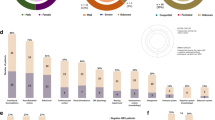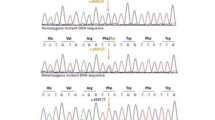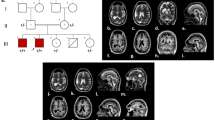Abstract
Objectives
Agnathia-otocephaly complex is a rare condition characterized by mandibular hypoplasia or agnathia, ear anomalies (melotia/synotia) and microstomia with aglossia. This severe anomaly of the first branchial arch is most often lethal. The estimated incidence is less than 1 in 70.000 births, with etiologies linked to both genetic and teratogenic factors. Most of the cases are sporadic. To date, two genes have been described in humans to be involved in this condition: OTX2 and PRRX1. Nevertheless, the overall proportion of mutated cases is unknown and a significant number of patients remain without molecular diagnosis. Thus, the involvement of other genes than OTX2 and PRRX1 in the agnathia-otocephaly complex is not unlikely. Heterozygous mutations in Cnbp in mice are responsible for mandibular and eye defects mimicking the agnathia-otocephaly complex in humans and appear as a good candidate. Therefore, in this study, we aimed (i) to collect patients presenting with agnathia-otocephaly complex for screening CNBP, in parallel with OTX2 and PRRX1, to check its possible implication in the human phenotype and (ii) to compare our results with the literature data to estimate the proportion of mutated cases after genetic testing.
Materials and methods
In this work, we describe 10 patients suffering from the agnathia-otocephaly complex. All of them benefited from array-CGH and Sanger sequencing of OTX2, PRRX1 and CNBP. A complete review of the literature was made using the Pubmed database to collect all the patients described with a phenotype of agnathia-otocephaly complex during the 20 last years (1998–2019) in order (i) to study etiology (genetic causes, iatrogenic causes…) and (ii), when genetic testing was performed, to study which genes were tested and by which type of technologies.
Results
In our 10 patients’ cohort, no point mutation in the three tested genes was detected by Sanger sequencing, while array-CGH has allowed identifying a 107-kb deletion encompassing OTX2 responsible for the agnathia-otocephaly complex phenotype in 1 of them. In 4 of the 70 cases described in the literature, a toxic cause was identified and 22 out the 66 remaining cases benefited from genetic testing. Among those 22 patients, 6 were carrying mutation or deletion in the OTX2 gene and 4 in the PRRX1 gene. Thus, when compiling results from our cohort and the literature, a total of 32 patients benefited from genetic testing, with only 34% (11/32) of patients having a mutation in one of the two known genes, OTX2 or PRRX1.
Conclusions
From our work and the literature review, only mutations in OTX2 and PRRX1 have been found to date in patients, explaining around one third of the etiologies after genetic testing. Thus, agnathia-otocephaly complex remains unexplained in the majority of the patients, which indicates that other factors might be involved. Although involved in first branchial arch defects, no mutation in the CNBP gene was found in this study. This suggests that mutations in CNBP might not be involved in such phenotype in humans or that, unlike in mice, a compensatory effect might exist in humans. Nevertheless, given that agnathia-otocephaly complex is a rare phenotype, more patients have to be screened for CNBP mutations before we definitively conclude about its potential implication. Therefore, this work presents the current state of knowledge on agnathia-otocephaly complex and underlines the need to expand further the understanding of the genetic bases of this disorder, which remains largely unknown.
Clinical relevance
We made here an update and focus on the clinical and genetic aspects of agnathia-otocephaly complex as well as a more general review of craniofacial development.


Similar content being viewed by others
References
Pauli RM, Pettersen JC, Arya S, Gilbert EF (1983) Familial agnathia-holoprosencephaly. Am J Med Genet 14(4):677–698. https://doi.org/10.1002/ajmg.1320140411
Gaba AR, Anderson GJ, VanDyke DL, Chason JL (1982) Alobar holoprosencephaly and otocephaly in a female infant with a normal karyotype and placental villitis. J Med Genet 19(1):78
Carles D, Serville F, Mainguene M, Dubecq JP (1987) Cyclopia-otocephaly association: a new case of the most severe variant of agnathia-holoprosencephaly complex. J Craniofac Genet Dev Biol 7(2):107–113
Hersh JH, McChane RH, Rosenberg EM, Powers WH Jr, Corrigan C, Pancratz L (1989) Otocephaly-midline malformation association. Am J Med Genet 34(2):246–249. https://doi.org/10.1002/ajmg.1320340223
Blaas HG, Eriksson AG, Salvesen KA, Isaksen CV, Christensen B, Mollerlokken G, Eik-Nes SH (2002) Brains and faces in holoprosencephaly: pre- and postnatal description of 30 cases. Ultrasound Obstet Gynecol 19(1):24–38. https://doi.org/10.1046/j.0960-7692.2001.00154.x
Louryan S, Vanmuylder N, Rooze M (2002) Computed tomography of a cyclotocephalic neonate. Surg Radiol Anat 24(5):319–323. https://doi.org/10.1007/s00276-002-0043-4
Reinecke P, Figge C, Majewski F, Borchard F (2003) Otocephaly and holoprosencephaly in only one monozygotic twin. Am J Med Genet A 119A(3):395–396. https://doi.org/10.1002/ajmg.a.20073
Hwang KS, Ding DC, Chang YK, Chen WH, Chu TY (2007) Otocephaly. J Chin Med Assoc 70(7):298–301. https://doi.org/10.1016/S1726-4901(07)70009-6
Chaoui R, Heling KS, Thiel G, Karl K (2011) Agnathia-otocephaly with holoprosencephaly on prenatal three-dimensional ultrasound. Ultrasound Obstet Gynecol 37(6):745–748. https://doi.org/10.1002/uog.9009
Wai LT, Chandran S (2017, 2017) Cyclopia: isolated and with agnathia-otocephaly complex. BMJ Case Rep. https://doi.org/10.1136/bcr-2017-220159
Porteous ME, Wright C, Smith D, Burn J (1993) Agnathia-holoprosencephaly: a new recessive syndrome? Clin Dysmorphol 2(2):161–164
Tos T, Ceylaner S, Senel S, Aktas S, Alp Y (2010) A case of otocephaly with anencephaly and meningomyelocele. Genet Couns 21(3):325–328
Puvabanditsin S, Garrow E, Umaru S, Padilla J, Chowdawarapu S, Biswas A (2006) Otocephaly, and pulmonary malformation association: two case reports. Genet Couns 17(2):167–171
Chen CP, Wang KG, Huang JK, Chang TY, Lin YH, Chin DT, Tzen CY, Wang W (2003) Prenatal diagnosis of otocephaly with microphthalmia/anophthalmia using ultrasound and magnetic resonance imaging. Ultrasound Obstet Gynecol 22(2):214–215. https://doi.org/10.1002/uog.135
Arizawa M, Nakamuro K, Watanabe A (1988) A case report of otocephaly with adrenal hypoplasia and genital anomalies. Nihon Sanka Fujinka Gakkai Zasshi 40(3):400–402
Schiffer C, Tariverdian G, Schiesser M, Thomas MC, Sergi C (2002) Agnathia-otocephaly complex: report of three cases with involvement of two different Carnegie stages. Am J Med Genet 112(2):203–208. https://doi.org/10.1002/ajmg.10672
Pauli RM, Graham JM Jr, Barr M Jr (1981) Agnathia, situs inversus, and associated malformations. Teratology 23(1):85–93. https://doi.org/10.1002/tera.1420230111
Faye-Petersen O, David E, Rangwala N, Seaman JP, Hua Z, Heller DS (2006) Otocephaly: report of five new cases and a literature review. Fetal Pediatr Pathol 25(5):277–296
Shermak MA, Dufresne CR (1996) Nonlethal case of otocephaly and its implications for treatment. J Craniofac Surg 7(5):372–375
Chassaing N, Sorrentino S, Davis EE, Martin-Coignard D, Iacovelli A, Paznekas W, Webb BD, Faye-Petersen O, Encha-Razavi F, Lequeux L, Vigouroux A, Yesilyurt A, Boyadjiev SA, Kayserili H, Loget P, Carles D, Sergi C, Puvabanditsin S, Chen CP, Etchevers HC, Katsanis N, Mercer CL, Calvas P, Jabs EW (2012) OTX2 mutations contribute to the otocephaly-dysgnathia complex. J Med Genet 49(6):373–379
Golinko MS, Shetye P, Flores RL, Staffenberg DA (2015) Severe Agnathia-Otocephaly complex: surgical management and longitudinal follow-up from birth through adulthood. J Craniofac Surg 26(8):2387–2392. https://doi.org/10.1097/SCS.0000000000002150
Brecht K, Johnson CM 3rd (1985) Complete mandibular agenesis. Report of a case. Arch Otolaryngol 111(2):132–134
Khan A, Bourgeois J, Mohide P (2008) Agnathia-otocephaly complex in a fetus with maternal use of topical 1% salicylate. Clin Dysmorphol 17(1):75–76. https://doi.org/10.1097/MCD.0b013e3282f16979
Menezes GA, Araujo Junior E, Lopes J, Belmonte S, Tonni G, Werner H (2016) Prenatal diagnosis and physical model reconstruction of agnathia-otocephaly with limb deformities (absent ulna, fibula and digits) following maternal exposure to oxymetazoline in the first trimester. J Obstet Gynaecol Res 42(8):1016–1020. https://doi.org/10.1111/jog.13014
Goswami D, Kusre G (2015) Agnathia Holoprosencephaly and Situs Inversus in a neonate born to an alcoholic mother. J Clin Diagn Res 9(5):AD01–AD02. https://doi.org/10.7860/JCDR/2015/12733.5884
Benawra R, Mangurten HH, Duffell DR (1980) Cyclopia and other anomalies following maternal ingestion of salicylates. J Pediatr 96(6):1069–1071
Ibba RM, Zoppi MA, Floris M, Putzolu M, Monni G, Todde PF, Sardu G (2000) Otocephaly: prenatal diagnosis of a new case and etiopathogenetic considerations. Am J Med Genet 90(5):427–429
Dasouki M, Andrews B, Parimi P, Kamnasaran D (2013) Recurrent agnathia-otocephaly caused by DNA replication slippage in PRRX1. Am J Med Genet A 161A(4):803–808. https://doi.org/10.1002/ajmg.a.35879
Johnson WW, Cook JB 3rd (1961) Agnathia associated with pharyngeal isthmus atresia and hydramnios. Arch Pediatr 78:211–217
Krassikoff N, Sekhon GS (1989) Familial agnathia-holoprosencephaly caused by an inherited unbalanced translocation and not autosomal recessive inheritance. Am J Med Genet 34(2):255–257. https://doi.org/10.1002/ajmg.1320340227
Rust OA, Bofill JA, Boch HG, Roberts WE (1999) Familial inheritance of mandibular arch malformations affecting three individuals in one family. South Med J 92(5):505–509
Erlich MS, Cunningham ML, Hudgins L (2000) Transmission of the dysgnathia complex from mother to daughter. Am J Med Genet 95(3):269–274
Sergouniotis PI, Urquhart JE, Williams SG, Bhaskar SS, Black GC, Lovell SC, Whitby DJ, Newman WG, Clayton-Smith J (2015) Agnathia-otocephaly complex and asymmetric velopharyngeal insufficiency due to an in-frame duplication in OTX2. J Hum Genet 60(4):199–202. https://doi.org/10.1038/jhg.2014.122
Patat O, van Ravenswaaij-Arts CM, Tantau J, Corsten-Janssen N, van Tintelen JP, Dijkhuizen T, Kaplan J, Chassaing N (2013) Otocephaly-Dysgnathia complex: description of four cases and confirmation of the role of OTX2. Mol Syndromol 4(6):302–305. https://doi.org/10.1159/000353727
Sergi C, Kamnasaran D (2011) PRRX1 is mutated in a fetus with agnathia-otocephaly. Clin Genet 79(3):293–295. https://doi.org/10.1111/j.1399-0004.2010.01531.x
Balic A, Adams D, Mina M (2009) Prx1 and Prx2 cooperatively regulate the morphogenesis of the medial region of the mandibular process. Dev Dyn 238(10):2599–2613. https://doi.org/10.1002/dvdy.22092
Lu MF, Cheng HT, Kern MJ, Potter SS, Tran B, Diekwisch TG, Martin JF (1999) prx-1 functions cooperatively with another paired-related homeobox gene, prx-2, to maintain cell fates within the craniofacial mesenchyme. Development 126(3):495–504
ten Berge D, Brouwer A, Korving J, Martin JF, Meijlink F (1998) Prx1 and Prx2 in skeletogenesis: roles in the craniofacial region, inner ear and limbs. Development 125(19):3831–3842
ten Berge D, Brouwer A, Korving J, Reijnen MJ, van Raaij EJ, Verbeek F, Gaffield W, Meijlink F (2001) Prx1 and Prx2 are upstream regulators of sonic hedgehog and control cell proliferation during mandibular arch morphogenesis. Development 128(15):2929–2938
Martin JF, Bradley A, Olson EN (1995) The paired-like homeo box gene MHox is required for early events of skeletogenesis in multiple lineages. Genes Dev 9(10):1237–1249
Donnelly M, Todd E, Wheeler M, Winn VD, Kamnasaran D (2012) Prenatal diagnosis and identification of heterozygous frameshift mutation in PRRX1 in an infant with agnathia-otocephaly. Prenat Diagn 32(9):903–905. https://doi.org/10.1002/pd.3910
Celik T, Simsek PO, Sozen T, Ozyuncu O, Utine GE, Talim B, Yigit S, Boduroglu K, Kamnasaran D (2012) PRRX1 is mutated in an otocephalic newborn infant conceived by consanguineous parents. Clin Genet 81(3):294–297. https://doi.org/10.1111/j.1399-0004.2011.01730.x
Jones M, Chung J, Kimonis V, Gold JA (2017) A novel mutation of orthodenticle homeobox 2 contributing to a case of otocephaly initially diagnosed by prenatal ultrasound in the first trimester. Clin Dysmorphol 26(2):98–100. https://doi.org/10.1097/MCD.0000000000000145
Kamnasaran D, Morin F, Gekas J (2010) Prenatal diagnosis and molecular genetic studies on a new case of agnathia-otocephaly. Fetal Pediatr Pathol 29(4):207–211. https://doi.org/10.3109/15513811003796946
Herman S, Delio M, Morrow B, Samanich J (2012) Agnathia-otocephaly complex: a case report and examination of the OTX2 and PRRX1 genes. Gene 494(1):124–129. https://doi.org/10.1016/j.gene.2011.11.033
Ohkubo Y, Chiang C, Rubenstein JL (2002) Coordinate regulation and synergistic actions of BMP4, SHH and FGF8 in the rostral prosencephalon regulate morphogenesis of the telencephalic and optic vesicles. Neuroscience 111(1):1–17
Ueda Y, Yamaguchi R, Ikawa M, Okabe M, Morii E, Maeda Y, Kinoshita T (2007) PGAP1 knock-out mice show otocephaly and male infertility. J Biol Chem 282(42):30373–30380
Petryk A, Anderson RM, Jarcho MP, Leaf I, Carlson CS, Klingensmith J, Shawlot W, O'Connor MB (2004) The mammalian twisted gastrulation gene functions in foregut and craniofacial development. Dev Biol 267(2):374–386
Grobe K, Inatani M, Pallerla SR, Castagnola J, Yamaguchi Y, Esko JD (2005) Cerebral hypoplasia and craniofacial defects in mice lacking heparan sulfate Ndst1 gene function. Development 132(16):3777–3786. https://doi.org/10.1242/dev.01935
Hide T, Hatakeyama J, Kimura-Yoshida C, Tian E, Takeda N, Ushio Y, Shiroishi T, Aizawa S, Matsuo I (2002) Genetic modifiers of otocephalic phenotypes in Otx2 heterozygous mutant mice. Development 129(18):4347–4357
Armas P, Cachero S, Lombardo VA, Weiner A, Allende ML, Calcaterra NB (2004) Zebrafish cellular nucleic acid-binding protein: gene structure and developmental behaviour. Gene 337:151–161. https://doi.org/10.1016/j.gene.2004.04.031
Armas P, Margarit E, Mouguelar VS, Allende ML, Calcaterra NB (2013) Beyond the binding site: in vivo identification of tbx2, smarca5 and wnt5b as molecular targets of CNBP during embryonic development. PLoS One 8(5):e63234. https://doi.org/10.1371/journal.pone.0063234
Chen W, Liang Y, Deng W, Shimizu K, Ashique AM, Li E, Li YP (2003) The zinc-finger protein CNBP is required for forebrain formation in the mouse. Development 130(7):1367–1379
Abe Y, Chen W, Huang W, Nishino M, Li YP (2006) CNBP regulates forebrain formation at organogenesis stage in chick embryos. Dev Biol 295(1):116–127. https://doi.org/10.1016/j.ydbio.2006.03.012
Weiner AM, Sdrigotti MA, Kelsh RN, Calcaterra NB (2011) Deciphering the cellular and molecular roles of cellular nucleic acid binding protein during cranial neural crest development. Develop Growth Differ 53(8):934–947. https://doi.org/10.1111/j.1440-169X.2011.01298.x
Dewey FE, Pan S, Wheeler MT, Quake SR, Ashley EA (2012) DNA sequencing: clinical applications of new DNA sequencing technologies. Circulation 125(7):931–944. https://doi.org/10.1161/CIRCULATIONAHA.110.972828
Cheung SW, Bi W (2018) Novel applications of array comparative genomic hybridization in molecular diagnostics. Expert Rev Mol Diagn 18(6):531–542. https://doi.org/10.1080/14737159.2018.1479253
Sergi C, Schmitt HP (2000) The vesicular forebrain (pseudo-aprosencephaly): a missing link in the teratogenetic spectrum of the defective brain anlage and its discrimination from aprosencephaly. Acta Neuropathol 99(3):277–284
Margarit E, Armas P, Garcia Siburu N, Calcaterra NB (2014) CNBP modulates the transcription of Wnt signaling pathway components. Biochim Biophys Acta 1839(11):1151–1160. https://doi.org/10.1016/j.bbagrm.2014.08.009
Gekas J, Li B, Kamnasaran D (2010) Current perspectives on the etiology of agnathia-otocephaly. Eur J Med Genet 53(6):358–366. https://doi.org/10.1016/j.ejmg.2010.09.002
Dixon J, Jones NC, Sandell LL, Jayasinghe SM, Crane J, Rey JP, Dixon MJ, Trainor PA (2006) Tcof1/Treacle is required for neural crest cell formation and proliferation deficiencies that cause craniofacial abnormalities. Proc Natl Acad Sci U S A 103(36):13403–13408. https://doi.org/10.1073/pnas.0603730103
Weiner AM, Scampoli NL, Calcaterra NB (2012) Fishing the molecular bases of Treacher Collins syndrome. PLoS One 7(1):e29574. https://doi.org/10.1371/journal.pone.0029574
de Peralta MS, Mouguelar VS, Sdrigotti MA, Ishiy FA, Fanganiello RD, Passos-Bueno MR, Coux G, Calcaterra NB (2016) Cnbp ameliorates Treacher Collins syndrome craniofacial anomalies through a pathway that involves redox-responsive genes. Cell Death Dis 7(10):e2397. https://doi.org/10.1038/cddis.2016.299
Acknowledgments
We are extremely indebted to the patients and their families for their participation in this study.
Author information
Authors and Affiliations
Contributions
Charlotte Dubucs collected and analyzed data and wrote the first draft of the manuscript. Julie Plaisancié conceived of and supervised the study and revised the manuscript. Marion Aubert-Mucca performed molecular analyses and analyzed data. Patrick Calvas and Nicolas Chassaing supervised the study and participated in the preparation of the manuscript. Consolato Sergi, Tania Attié-Bitach, Didier Lacombe, Christel Thauvin-Robinet Stéphanie Arpin, Marie Josée Perez, Christelle Cabrol, Chih-Ping Chen, Jacqueline Aziza, Estelle Colin, and Jelena Martinovic made the diagnosis of AGOTC and send patients’ DNA for molecular analyses. All authors read and approved the final version.
Corresponding author
Ethics declarations
Conflict of interest
The authors declare that they have no conflict of interest.
Ethical approval
According to the French rules and regulations, the current study was approved by the ad hoc French Ethics Committee Comité de Protection des Personnes (CPP) Sud-Ouest et Outre-Mer II (# DC-2008-463).
Informed consent
Informed consent was obtained from all individual participants included in the study.
Additional information
Publisher’s note
Springer Nature remains neutral with regard to jurisdictional claims in published maps and institutional affiliations.
Electronic supplementary material
ESM 1
(DOC 47 kb).
Rights and permissions
About this article
Cite this article
Dubucs, C., Chassaing, N., Sergi, C. et al. Re-focusing on Agnathia-Otocephaly complex. Clin Oral Invest 25, 1353–1362 (2021). https://doi.org/10.1007/s00784-020-03443-w
Received:
Accepted:
Published:
Issue Date:
DOI: https://doi.org/10.1007/s00784-020-03443-w




